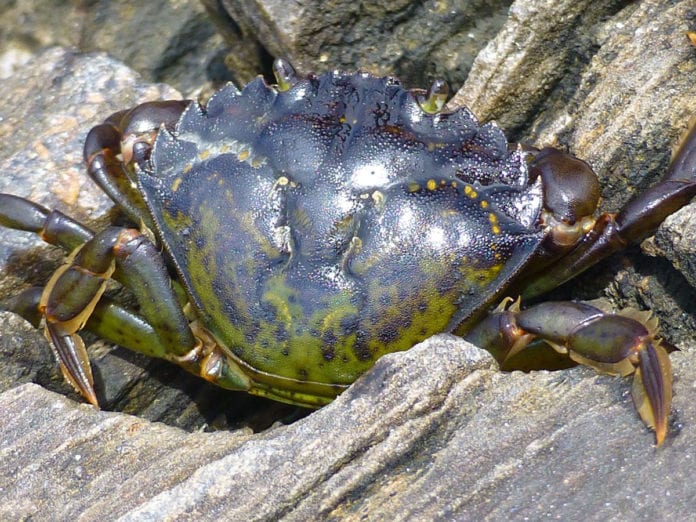Federal and state fisheries officials are collaborating to track the European green crab, as the invasive species which threatens juvenile king crab, juvenile salmon, eelgrass and more, gets closer to Alaska.
NOAA Fisheries officials said alarm bells went off for fisheries biologists in Alaska in July after reports came in that several adult male and female European green crabs were spotted on the archipelago of Haida Gwaii, off the coast of Prince Rupert, British Columbia, close to Alaska.
European green crabs first came to North America in the 1800s, likely hitching a ride in ballast water of merchant ships from Europe and were first detected in the San Francisco Bay area in 1989. The species has few predators, aggressively hunts and eats its prey, destroys seagrass and outcompetes local species for food and habitat.
Eleven communities included in the Alaska Green Crab Monitoring Program includes Cordova, Metlakatla, Ketchikan, Juneau, Valdez, Tatitlek, Whittier, Chenega Bay, Homer, Seward, Kodiak and Dutch Harbor.
Federal fisheries officials say the European green crab could potentially damage Alaska’s multi-billion-dollar fisheries, especially for salmon, crab and mariculture operations.
While no European green crab have been detected to date in Alaska waters, federal fisheries officials have already formed partnerships to monitor for this species, said Linda Shaw, invasive species coordinator for the Alaska regional office of NOAA Fisheries.
“The fact that this invasive crab is moving ever closer to Alaskan waters gives some urgency to what we are doing,” Shaw said, in a statement issued by NOAA.
While European green crabs are subject to predation from native species of other crab, fish, birds and mammals like mink and otter, they are considered effective at avoiding predation in other areas they have invaded, including New England, by their coloration ability to hide and ability to adapt to a wide range of environmental conditions, such as salinity, Shaw said.
“The more robust our biodiversity of natural predators here in Alaska, the better predation may diminish their ability to invade and establish,” she said.
Shaw and Meredith Pochardt of Alaska Sea Grant plan to use environmental Deoxyribonucleic acid (eDNA) to detect the possible presence of these crab in Alaskan waters. DNA is the molecule that contains the genetic code of organisms. The cellular material shed by organisms into the environment is eDNA. The plan is to collect seawater from various locations around Alaska and test it or European green crab genetic material.
In an initial effort in late October, researchers used Fukui fish traps supplied by the Alaska Department of Fish and Game. Larger efforts were initially delayed by the novel coronavirus pandemic, which involved mandatory travel restrictions.
Charlie Waters, a NOAA research fisheries biologist at the Alaska Fisheries Science Center, noted that with the eDNA as a fingerprint, researchers can use it to address questions for a variety of organisms, including detecting the presence and/or absence of particular species and also potentially estimating their abundance.
“You can tell what is in the water at a particular location at a particular point of time,” he said. “We hope to use eDNA for this project and many others.”
Given that anything in the water sheds cells and the DNA in those cells are unique to particular species, researchers can collect water from a single location at a single time, filter that water for cells, store the filter and take it to the lab to examine for eDNA to detect the presence and possible abundance of various organisms.
Shaw and Pochardt also coordinated with the Metlakatla Indian community on Annette Island, just north of Dixon Entrance marking the Canada-U.S. border, to monitor for European green crabs in 2020.
Meanwhile planning is underway to continue monitoring for European green crab in 2021.















